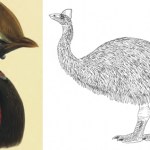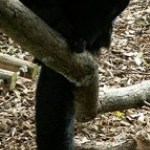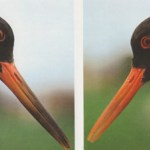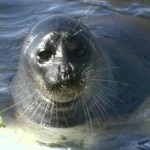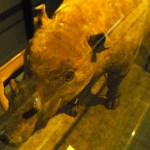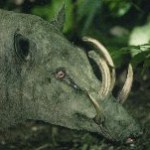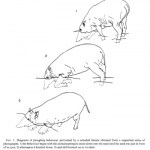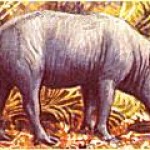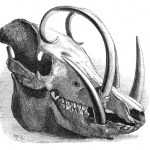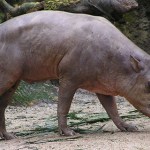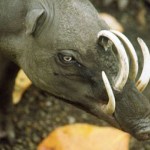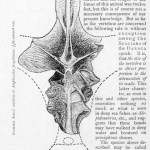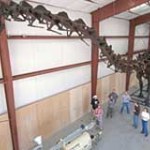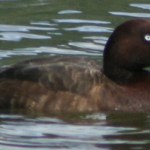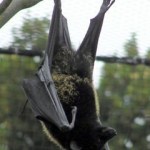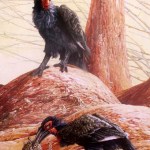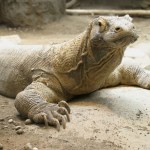From the Archives
I have a great liking for cassowaries, and I've had good reason to write about them several times. I've also had fun playing with preserved specimens and skeletons - something I must elaborate on at some time. Back in 2006 - the days of Tet Zoo ver 1 - I blogged some of my cassowary-related musings, and in the interests of both recycling and of getting credit for stuff I've already gotten credit for before, I repost them here. Partly due to laziness, I never did include the article you're about to read - some say one of my all-time greatest articles ever - in the book Tetrapod Zoology Book…
My recent brief mention of Thomas Huxley (in connection with the Dinosaurs and Other Extinct Saurians: A Historical Perspective volume) reminded me to look anew at this Tet Zoo ver 1 post from 2006...
Here's a little known fact. Charles Robert Darwin (1809-1882), the most important biologist of all time, did not spend his entire life as an old man. I despise stereotypes, especially those that are totally erroneous, and whenever I see a picture of 'old man Darwin' I wonder: why is it that so many of our most important scientists are consistently portrayed as old men? Don't get me wrong, I…
I'm away right now, and haven't had time to prepare new stuff. So, here's something from the archives again: by which I mean, something written in 2006. It's still pretty interesting (in my humble opinion), but I would definitely do some things differently were I to re-write it today [gliding sifaka below from Demes et al. (1991): read on].
Mention 'flying primate' and most zoologists will think you're referring to the well known, controversial theory of John Pettigrew of the University of Queensland. And if that sentence sounds familiar, it's because I used it previously to introduce a…
Inspired both by the clam catches oystercatcher story, and by Greg Laden's coverage of oystercatcher learning and predation behaviour, I thought it an opportune time to recycle the following from Tet Zoo ver 1. It originally appeared as one of my Ten Bird Meme posts of 2006...
One of my most favourite birds is the extraordinary, charismatic, beautifully interesting oystercatcher (meaing Eurasian oystercatcher Haematopus ostralegus: adjacent photo by Bjørn Christian Tørrissen, from wikipedia). One of ten or eleven extant haematopodid species, it sports pied plumage, pinkish legs, and has…
How the hell did seals get into Lake Baikal? Actually, if you're a long-time reader you'll know the answers that have been put forward (note there that I didn't say "you'll know the answer"), as I covered this issue back in 2006 on Tet Zoo ver 1. In the interests of recycling old stuff and saving myself valuable time and effort, here's that article again...
One of the most asked about questions I've encountered in tetrapod zoology concerns the mysterious seals of Siberia's Lake Baikal. Everyone knows that an endemic, particularly small species of land-locked freshwater seal lives there,…
No time for anything new (working on a book chapter and putting the finishing touches to the Tet Zoo book), so here's this, from the archives. NOT properly updated, so please be aware that it's more than four years old...
There are three extant manatee species*: Trichechus inunguis of the Amazon Basin, T. manatus of the Gulf of Mexico, Caribbean and US Atlantic coast as far north as Virginia, and T. senegalensis of western Africa. So, how it is that they occur on opposite sides of the Atlantic? [West Indian manatee T. manatus shown here, from wikipedia. This one was photographed in Florida…
In the previous article we looked at the proposal that the various babirusa taxa - long regarded as subspecies - deserve to be raised to species rank. The argument goes that the taxa concerned are (1) morphologically diagnosable, (2) 'as distinct' as are other taxa traditionally regarded as species (raising the taxa to species level therefore represents a sort of attempt at uniformitarianism), and (3) represent distinct phylogenetic lineages. Meijaard & Groves's proposal therefore reflects their adherance to the phylogenetic species concept, or PSC (where distinct lineages on a…
Welcome to yet another article in the (outstandingly successful, yet recycled from ver 1) series on babirusas. Observant readers will have noticed that, strangely, I've refrained thus far from using a scientific binomial for babirusas, plus I've consistently (I think) referred to them in the plural, and not as a single species. What gives?
Well, the proverbial cat is already out of the bag, but the traditional taxonomy where all babirusas are referred to the single species Babyrousa babyrussa is now defunct and there are good reasons for recognising several species. Babirusa taxonomy was…
The bipedal 'boxing' behaviour of babirusas is odd, but arguably odder is a unique sort of 'ploughing' behaviour they've recently been shown to practise. On being presented with an area of soft sand, captive babirusas (mostly males) have been noted to kneel down and push their head and chest forward through the sand, the result being a deep furrow. One obscure report from the 1970s suggests that Sulawesi people associated babirusas with the creation of straight-line furrows. Possible babirusa furrows were reported from south-eastern Sulawesi in 2002, but this behaviour has otherwise gone…
In the previous articles we looked at the distribution and phylogenetic position of babirusas, and also at a bit of their behaviour, biology and morphology. While babirusas are famous for the bizarre upper canines that emerge from the dorsal surface of the snout in males, the function of these teeth remains uncertain. As we saw in the previous article, it's been proposed that they function in display, in fighting, or in helping the animal to push its way through dense vegetation. The latter idea is least likely and is unsupported by observations. The fighting idea might seem logical and…
Another article on babirusas - yaay! Like many (but not all) pigs, babirusas are omnivorous, and are said to eat invertebrates whenever they find them. They have also been reported to eat fish on occasion, to catch small mammals, and even to catch and eat the juveniles of other babirusas (Leus & Morgan 1995). They eat all kinds of plant material, including fruits, leaves, flowers, berries, nuts, bark and tubers, and they not only browse and dig to obtain such items, they are also surprisingly good at standing bipedally (without support) to feed on leaves. This again is a curious parallel…
More on babirusas! Go here for part I.
While babirusas look pig-like and are classified as part of Suidae, they're distinctive and unusual [image above from wikipedia]. Combining rather slender legs with a barrel-shaped body, they can exceed 1 m in length and have a shoulder height of 65-80 cm. Some individuals weigh as much as 100 kg. Babirusas are odd in having particularly remarkable canines (more about those soon), but less well known is that they differ from other pigs in several details of their anatomy, and in fact resemble peccaries and other artiodactyls in a few features. The…
In the interests of recycling old material from Tet Zoo ver 1, I present... yes, a whole series of articles devoted to one of the most unusual and remarkable of hoofed mammals. Come on, we all love babirusas. If you've been with Tet Zoo from the beginning, none of what's to follow will be new [adjacent photo from here]. For the rest of you: buckle up and enjoy the ride...
You might be surprised to learn that babirusas have been known to westerners for a comparatively long time, having been named Sus babyrussa by Linnaeus in 1758 (the generic name Babyrousa was first coined by Perry in 1811…
By popular demand... it's the second part of the old, old, old (ver 1) article I wrote in 2006 on the obscure and poorly known mega-sauropod Amphicoelias fragillimus. Be sure to read part I first.
So, A. fragillimus was described in 1878 on the basis of an incomplete but enormous dorsal vertebra and the distal end of a femur [both reconstructed in the image below]. The details of these bones show that A. fragillimus was a diplodocoid, and thus related to more familiar taxa like Diplodocus and Apatosaurus. Despite its absurd size - suggesting (by comparison with other diplodocoids) a total…
Hope you had a good Christmas - I did! Here's an old article from Tet Zoo ver 1, apologies if you recall it from its first airing in 2006. The article is now a bit dated - sorry about that (I've added one or two new bits).
Even if you're not an expert on dinosaurs, it's likely that you've heard - firstly - that some sauropods were rily, rily big and - secondly - that these biggest of the big included such whoppers as Seismosaurus, Supersaurus and Argentinosaurus. It's always helpful that their names are easy to remember. Recent work has not only resulted in the publication of reasonably…
The other day I took my dogs to the vet for a checkup and saw a woman with her morbidly obese dog waiting to fill her prescription for Slentrol -- the first obesity drug for dogs -- which made me feel the need to resurrect this post below, which I wrote the day the FDA announced they'd approved the drug for use in dogs:
The FDA just announced that they've just approved the first-ever obesity drug for dogs, which really makes me cringe. Why? Because dogs don't have eating disorders -- their owners have feeding disorders.
This
summer, I adopted a new dog after she ran in front of my car…
The recent article about Meller's duck Anas melleri inspired me to recycle my ver 1 article about another of Madagascar's endemic ducks, the Madagascar pochard Aythya innotata [male shown below]. Meller's duck is endangered, with a global population of between 3000 and 5000, but the Madagascar pochard is in an even worse position: in fact, it was regarded as extinct until 2006, when a small group of less than 20 was discovered (read on).
In fact, just last month a joint group representing the Durrell Wildlife Conservation Trust, the Wildfowl and Wetlands Trust, The Peregrine Fund, and…
Some time during the last several hours (while I was asleep), Tet Zoo reached the three million hits mark. Yes, three million hits in two years (Tet Zoo ver 2 was launched on Jan 31st 2007). A noble achievement, I'm sure you'll agree. Due to workload and assorted other commitments, I still don't have anything major new to post (how the hell do the more prolific bloggers do it?), though there was the new salamander thing yesterday - knocked up very quickly on the spur of the moment - and I've also just produced a new SV-POW! article. Inspired by a comment Nathan Myers left here recently…
The photo of the Northern ground hornbill Bucorvus abyssinicus featured here yesterday was posted entirely on a whim. And I figured that I didn't need to say much about the species, nor about ground hornbills in general, given that they've been discussed at length on Tet Zoo before. But then I realised that the only in-depth treatment of ground hornbills at Tet Zoo comes from ver 1, and thus dates to 2006. That's three years ago. Given that so much has changed in terms of Tet Zoo's readership, it's clearly time to re-post this old, classic article. If you remember it from the first time…
The proofs for one of my books arrived the other day, so I have been busy busy busy. This (in part) explains the lack of action here on the blog, and the preponderance of recycled stuff. Sorry about that. In fact, sorry, here's another recycled article from Tet Zoo ver 1. Hopefully I'll have the time to produce some new content over the next week, but don't hold your breath. And sorry about all the dinosaur stuff: I know you much prefer it when I post on frogs, lizards, mice and passerines. Anyway...
As a kid I always got the impression from textbooks that the only tetrapods (and thus only…
